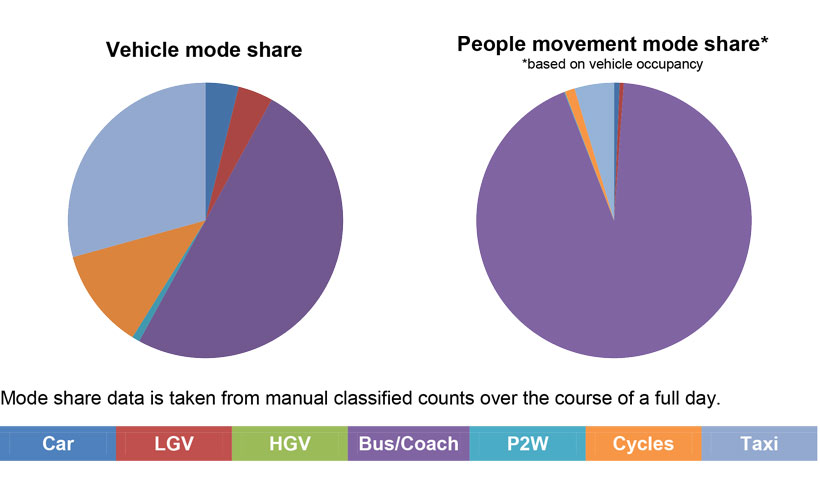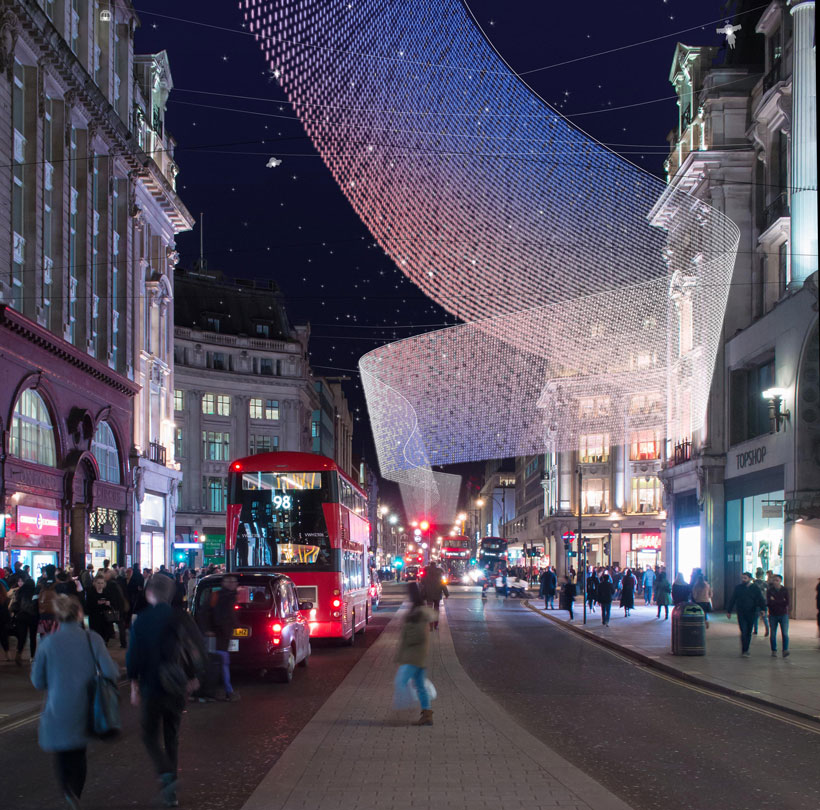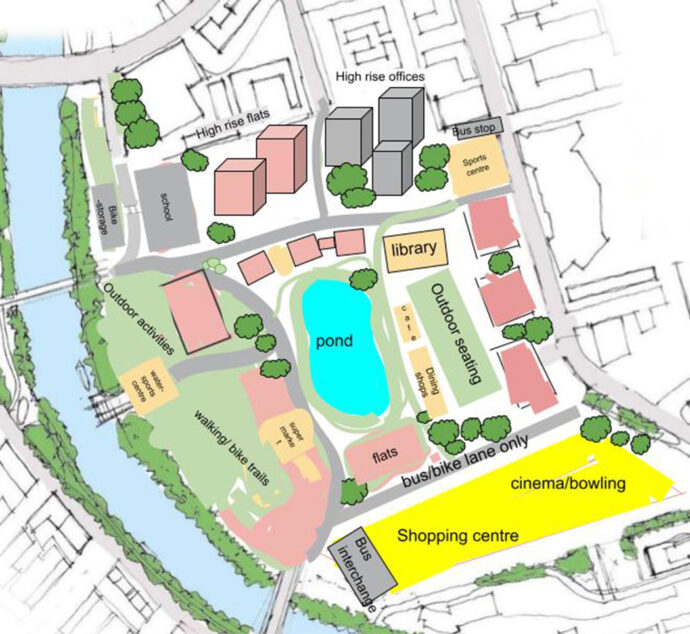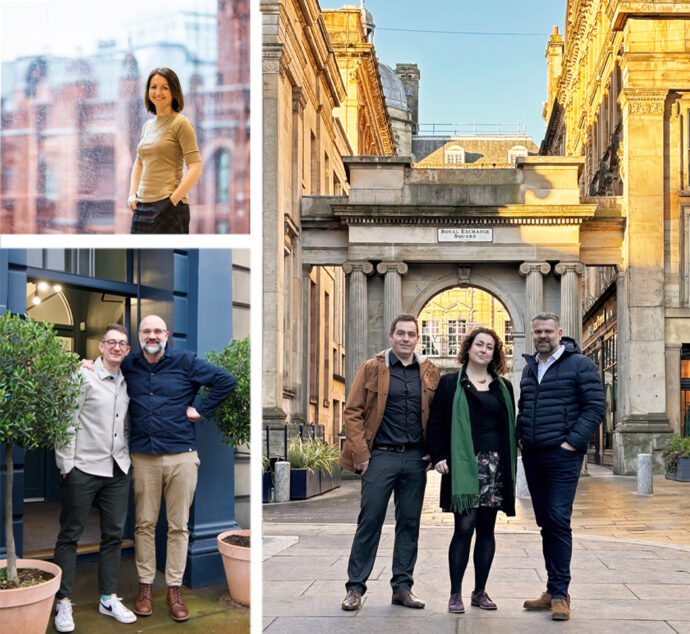As I write this article, I find myself gazing down upon the long queues of red buses that define the 2km stretch of Oxford Street running from Tottenham Court Road to Marble Arch. Our 3DReid London studio is located almost directly across from the hotly anticipated IKEA store – we have a small roof terrace that allows for long distance views both east and west. Yet the tired white star-lights unboxed and strung up for yet another year of re-use, swing and tangle languidly in the October breeze – a metaphor for how little we celebrate our city centres.
Oxford Street is the busiest retail street in Europe and historically one of London’s most iconic shopping destinations, attracting 500,000 visitors per day. However, with heavy traffic congestion, air pollution and growing safety concerns, pedestrianising Oxford Street has been a topic of debate for years and is now closer than ever to being realised. Transforming it into a pedestrian-only zone offers potential benefits but also presents significant challenges.
Our newly emboldened Mayor has decided to dust off his plans to pedestrianise Oxford Street and that includes appointing a new team to envision what its future may hold, even if only the truncated stretch between Oxford Circus and Marble Arch.
What are the Pros of Pedestrianising Oxford Street?
-
-
Improved Air Quality and Environmental Benefits
Oxford Street is one of the most polluted streets in the UK due to the high volume of buses, taxis, and delivery vehicles. Pedestrianisation would significantly reduce vehicular emissions, improving air quality for shoppers, workers, and local residents. Moreover, TfL’s push for its electric bus fleet would significantly increase the air quality in the surrounding areas. Cleaner air is essential to addressing health concerns like respiratory issues, particularly in densely populated urban areas like central London. Such a shift also aligns with London’s broader sustainability goals, such as reducing carbon emissions and combating climate change.

-
Enhanced Safety and Walkability
A pedestrian-only Oxford Street would eliminate the risks posed by traffic accidents. The street is notorious for being crowded, with a dangerous cocktail of fast-moving traffic and distracted tourists, many of whom look at their phones and not the pavement/road in front of them. Spend 5 minutes watching any of the several T-junctions visible from our terrace and you will see a near miss before long. Electric hire bikes are an increasing menace that are exacerbating the risk to pedestrians. Reported casualties involving e-bikes on London’s roads rose 15-fold from 2018 to 2021. By restricting vehicles and e-bikes, or at least providing clear cycle highways, the street would become safer for people to navigate, especially for families, the elderly and those with mobility issues. A safer, more walkable Oxford Street could encourage more people to visit, boosting the area’s appeal as a world-class shopping destination.
-
Boost to Retail and Tourism
A more pleasant, pedestrian-friendly Oxford Street would invigorate tourism and retail businesses. With increased footfall, retailers may see higher sales and the overall shopping experience would be more enjoyable without the noise, pollution and hazards of traffic. Pedestrianised areas, such as Covent Garden and Regent Street during weekends have seen significant economic success. Removing cars also allows for the possibility of more public spaces, outdoor events, or even green zones, which could act as green-lungs for the city, encouraging biodiversity and further attracting visitors to dwell longer. The boon that the Elizabeth Line and much improved TCR tube station has brought to the Eastern end of Oxford Street is clear to see, with a near reversal in fortunes between the tow ends of the street in the time we have been located here.
-
Urban Aesthetic and Community Spaces
Try and find somewhere pleasant to sit and eat an overpriced sandwich at lunchtime and you’ll likely be sat in a shaded side street with limited, dirty furniture and unwholesome neighbours. Transforming Oxford Street could provide opportunities to redesign the street with wider pavements, street furniture, art installations, or greenery, fostering a more attractive urban environment and something more fitting for Europe’s busiest shopping street that gives Les Champs Elysees or Las Ramblas a run for their money. This could shift Oxford Street from being purely commercial to a more holistic public space that serves both leisure and community purposes, with the street itself becoming the destination and not just the shops that adorn it.
-
© 3DReid and Midjourney AI
And The Cons?
-
-
Impact on Public Transport and Traffic
Oxford Street is a major thoroughfare for buses and taxis, with several bus routes relying on the street. Pedestrianisation could complicate these routes, leading to increased congestion on surrounding streets as traffic is diverted. This may exacerbate delays and negatively affect residents and commuters who depend on public transport. Additionally, deliveries to the numerous stores on Oxford Street could be hindered, creating logistical challenges for businesses. Considering managed servicing and out of hours deliveries will take more forward looking and flexible landlord and occupier collaboration. Until the delivery drones are ready, that is.
-
Cost and Infrastructure Challenges
Pedestrianising Oxford Street would require significant investment in infrastructure. This includes new road layouts, alternative transport routes, and possible underground services to compensate for the absence of street-level transport. The upfront cost could be substantial, and there are concerns about who would bear the financial burden—local government, businesses, or taxpayers. Rates contributions based upon a percentage of sales turnover may incentivise business tenants to support proposals if they benefit directly from the increased footfall that results from pedestrianisation.
-
Possible Negative Impact on Accessibility
While making the street pedestrian-friendly is a boon for many, there are concerns about accessibility for those with disabilities or limited mobility who rely on buses or taxis. Without careful planning, pedestrianisation could unintentionally isolate certain groups by reducing easy access to Oxford Street’s shops and services.
-
Resistance from Businesses and Commuters
Businesses, particularly those reliant on deliveries or customer access by car, may oppose pedestrianisation. They may fear that reduced vehicular access could lead to lower sales or logistical difficulties. Similarly, commuters and local workers could experience disruption, especially during the transition period.
-
The pedestrianisation of Oxford Street offers a promising vision of cleaner air, safer streets, and an enhanced shopping experience. However, it comes with logistical, financial, and accessibility challenges. Balancing these pros and cons requires careful planning, stakeholder engagement, and innovative transport solutions to ensure that such a transformation benefits the entire city. It may be that a trial period over a few weeks or months may be the best way to take the proposal forward before fully committing to permanent changes in infrastructure.
After what seems like a decade of austerity, exacerbated by masochistic mini-budgets and pandemics alike, the retail sector is finally beginning to flourish once more. Despite the ongoing challenges of a cost-of-living crisis, the packed stores and handfuls of shopping bags swinging into the sunset over Marble Arch tell a different story. It’s time we made a more continental scale grand gesture and celebrated one of the icons of London and made it a place that stands out from the crowds, or at least a pleasant and safe place for them to eat, shop and stay. We need bolder vision, stronger politicians and the willingness to risk investment for longer term gain. A better Oxford Street will generate significantly more investment in our city and will pay for itself many times over.

Image: 3DReid Christmas Lights Competition Entry











